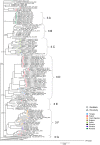Genetic diversity of PRRSV 1 in Central Eastern Europe in 1994-2014: origin and evolution of the virus in the region
- PMID: 29773820
- PMCID: PMC5958080
- DOI: 10.1038/s41598-018-26036-w
Genetic diversity of PRRSV 1 in Central Eastern Europe in 1994-2014: origin and evolution of the virus in the region
Abstract
More than 20 years after the first outbreaks, the phylogenetic picture of PRRSV is still incomplete and full of gaps, especially in regards of PRRSV 1. Due to the exceptional diversity observed at the eastern borders of Europe and the low number of available sequences from Central Eastern European countries, the authors collected and analyzed both recent as well as already submitted sequences comparing them to a large backbone set of available ORF5 sequences representing the full spectrum of PRRSV 1 Subtype 1 diversity to conduct a systematic phylogenetic analysis and reclassification elucidating the diversity of the virus in these countries. Moreover, further analyses of the EUROSTAT data regarding the live pig movement trends revealed their influence of virus diversity and evolution. The results indicate that besides the effect of local, isolated divergent evolution and the use of modified live vaccines, the most important factor influencing a given country's virus diversity is the transboundary movement of live, infected animals.
Conflict of interest statement
The authors declare no competing interests.
Figures





References
-
- Holtkamp DJ, et al. Assessment of the economic impact of porcine reproductive and respiratory syndrome virus on United States pork producers. J. Swine Heal. Prod. 2013;21:72–84.
-
- Keffaber KK. Reproductive failure of unknown etiology. Assoc. Swine Pract. Newsl. 1989;1:1–9.
-
- Lindhaus W, Lindhaus B. Mystery Swine Disease. Prakt. Tierartz. 1991;72:423–425.
Publication types
MeSH terms
Substances
LinkOut - more resources
Full Text Sources
Other Literature Sources

